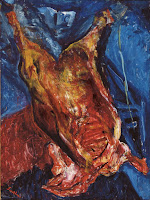We were given the task of doing a tonal painting using a minimal palette(blue,brown,black & white) from an oddly shaped structure which had white cloth wrapped around it. Lights on the floor were shone on to it to emphasize the highlights and tones of the creases and folds of cloth.


I wasn't entirely pleased with my painting at the end of the day, feeling that it lacked detail and depth. So I contiuned to work on it a few days later and achieved the result I was aiming for.
The subject matter of this painting was not something I was entirely keen on painting and at first glance there didn’t appear to be enough “substance” to take from it. However, it was clear that it was the detail of the highlights and tones that were going to be important to achieve a tonal painting. I aimed to outline roughly the form of the sculpture with charcoal and build up the composition with the three chosen oil paints.
By doing this painting and looking at how other people approached it, it confirmed my thoughts of how artists always interpret subject matter for paintings in such individual ways. What one artist sees or depicts in an object can vary immensely from another artist. My feelings at the beginning towards the this type of painting changed the more I got into it, and by the end I quite enjoyed working with the limited palette and also the fact that it was on such a large scale.
Generally, I enjoy using a lot of detail in my drawings and paintings but this piece made me really look at the detail of the folds in the fabric and how it catches the lights so intensely at certain points, yet it can be so dark at others. This however wasn’t so apparent to me at first, but I learned that the more you looked at the object the more you began to see, and this showed me that it is possible to take a lot from a “simple” object.
I used to think that you could only create a painting which had meaning to you if you painted an object/scene/subject that had meaning to you. Though it became clear to me that it doesn’t necessarily matter what the subject of your painting was, you always make it into something you want it to be. It is you the artist who decides what to paint, what to leave out, what to alter, making it an object in itself. So it occurred to me that sometimes the subject matter of a painting is irrelevant since you make it into something in itself, something that you want to see, anyway.
From what Berger was saying about the endless transience of the subject of paintings, I felt that as I progressed with this particular piece I was constantly altering and redoing lines and tones for the sculpture appeared to be in constant transformation and my perception of it was continually changing too.










 The Man In Prayer
The Man In Prayer  Glaieuls Rouges
Glaieuls Rouges  Carcass of Beef
Carcass of Beef
 Judith Beheading Holofernes
Judith Beheading Holofernes  Self-portrait as Sick Bacchus
Self-portrait as Sick Bacchus  St.Matthew & the Angel
St.Matthew & the Angel .jpg) The Cardsharps (I Bari)
The Cardsharps (I Bari)  The Rest on the Flight to Egypt
The Rest on the Flight to Egypt







+022.jpg)
+011.jpg)